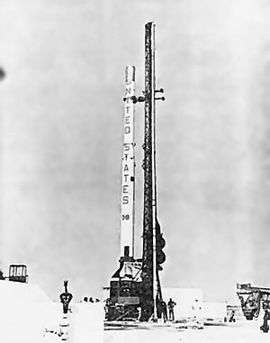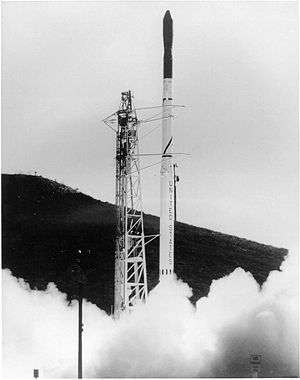RM-90 Blue Scout II
 | |
| Function |
Expendable launch system Sounding rocket |
|---|---|
| Manufacturer | Vought |
| Country of origin | United States |
| Size | |
| Height | 24 metres (79 ft) |
| Diameter | 1.02 metres (3 ft 4 in) |
| Mass | 16,874 kilograms (37,201 lb) |
| Stages | Four |
| Capacity | |
| Payload to LEO | 30 kilograms (66 lb) |
| Associated rockets | |
| Family | Scout |
| Launch history | |
| Status | Retired |
| Launch sites | Canaveral LC-18B |
| Total launches | 3 |
| Successes | 2 |
| Failures | 1 |
| First flight | 1961-03-03 |
| Last flight | 1961-11-01 |
| First stage - Algol 1B | |
| Engines | 1 solid |
| Thrust | 471 kilonewtons (106,000 lbf) |
| Specific impulse | 236 sec |
| Burn time | 40 seconds |
| Fuel | Solid |
| Second stage - Castor 1A | |
| Engines | 1 solid |
| Thrust | 286 kilonewtons (64,000 lbf) |
| Specific impulse | 247 sec |
| Burn time | 27 seconds |
| Fuel | Solid |
| Third stage - Antares 1A | |
| Engines | 1 X-254 |
| Thrust | 60 kilonewtons (13,000 lbf) |
| Specific impulse | 256 sec |
| Burn time | 39 seconds |
| Fuel | Solid |
| Fourth stage - Altair 1A | |
| Engines | 1 X-248A |
| Thrust | 14 kilonewtons (3,100 lbf) |
| Specific impulse | 255 sec |
| Burn time | 40 seconds |
| Fuel | Solid |
The RM-90 Blue Scout II was an American sounding rocket and expendable launch system which was flown three times during 1961. It was used for two HETS test flights, and the launch of the Mercury-Scout 1 satellite for NASA. It was a member of the Scout family of rockets.
The Blue Scout II was a military version of the NASA-operated Scout X-1. All three launches occurred from Launch Complex 18B at the Cape Canaveral Air Force Station, the same launch pad used for the Blue Scout I. The first two launches were successfully conducted on 3 March and 12 April 1961 respectively. They both carried HETS A2 plasma research experiments on suborbital trajectories. The third launch was conducted on 1 November, with the Mercury-Scout 1 satellite for NASA, which was intended to reach low Earth orbit. The launch failed after the rocket went out of control, and was destroyed by the range safety officer 43 seconds after liftoff.
References
- Wade, Mark. "Scout". Encyclopedia Astronautica. Retrieved 2009-06-20.
- Krebs, Gunter. "Scout". Gunter's Space Page. Retrieved 2009-06-20.
- McDowell, Jonathan. "Scout". Orbital & Suborbital Launch Database. Jonathan's Space Page. Retrieved 2009-06-20.
- Heyman, Jos; Parsch, Andreas (2007-07-09). "LTV SLV-1 Scout". Appendix 3: Space Vehicles. Directory of U.S. Military Rockets and Missiles. Retrieved 2009-06-20.
